|

| (continued) In the fall of 2007
and 2009,
Michael's medical students at Kunming Medical University created the
following descriptions of portions of a mural in Kunming. (Each group also
did an oral presentation.) By reading these
academic paragraphs, I hope you learn some things about the history
and practice
of medicine in China. (If you find mistakes with the "facts" on this
page, please let me know. Thanks.)
Click here for page one |
|

Cooperation is Key in Diagnosis and
Therapy
In the modern medical community,
cooperation is of the utmost importance in diagnosis and therapy, as
doctors and patients work together to fight disease. In the past, doctors
who worked alone had low efficiency and limited success in diagnosis and
treatment, because no one helped them improve themselves. Since health
care reforms have been put into effect, however, hospitals work as a big
and united team. The diagnostician who figures out the cause of disease,
the radiologist who takes X-rays, the orthopedic doctor who sets broken
bones, and the nurse who takes care of patients--all these different
medical professionals cooperate and assist each other in saving lives. In
addition, cooperation between doctors and patients is the foundation for
successful therapy, which may protect the interests of both sides. If
doctors and patients understand, respect, and support each other, disease
can be treated in a cheerful and soothing environment. Consequently,
doctors, who don’t work alone any more, cooperate with different medical
professionals and patients to fight disease, which helps to make the
modern medical community more peaceful.
Group L09:
Dolly, Andy, Cyrix, Li Guo Liang, Bai Min, Vicki
As
we can see from the picture, the doctors are examining the patients with
some medical tools in the hospital. Through these practices, doctors can
diagnose a patient's problems. Long ago, our ancestors used some simple
ways to distinguish between diseases, but diagnosis has always been very
important in the process of therapy. For example, 望闻问切 (wàngwénwènqiè;
watching the face, smelling, asking questions, and feeling the pulse) are
well known as methods of diagnosis in Chinese traditional medicine. With
the development of science, these methods have been improved and have
gradually become a bridge connecting basic medicine with clinical
medicine, so they are the fundamental subject of all clinical medical
courses. Modern diagnosis includes three parts: (1) systemic, careful and
skillful inquisition into the symptoms; (2) physical examination
(inspection/ palpation/ percussion/ auscultation and smelling); and (3)
lab tests and examination with machines. Modern medical tools give doctors
crucial information, because if can we master the diagnostic methods, we
can give better services to the patients. Team L07: Gloria, Tina, Yuan Limei, Yu Guihui, Henry |
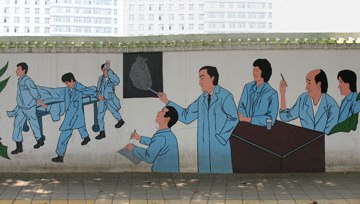
Doctors and Patients Fight Cardiac
Disease Together
As vividly displayed in this picture,
cardiac physicians and patients both play an important role in reducing
heart disease mortality. According to the World Heart Federation,
among three deaths worldwide, one person’s death is caused by
cardiovascular (心血管)
disease. That terrible number shows why the contribution of cardiac
physicians is so important. First, emergency measures must be taken
rapidly to save patients’ lives. If patients are rescued successfully,
then doctors prescribe medication to prevent the conditions from
deteriorating. Doctors also take preventive measures in order to let the
high-risk groups understand what the risks of cardiovascular disease are.
The patients’ important role is to stay far away from risk factors. Four
common reasons for heart disease are understood: the environment, tobacco,
alcohol and genetic factors. People can avoid them (except heredity) and
can also increase physical activity to keep healthy. In addition to these,
cooperating with doctors is also important. In treating and preventing
incidence of cardiovascular disease, physicians’ treatment can not be
separated from patients’ self-awareness.
Group M09:
Larry, Vivian, Eileen, Geng Hongchun, DingChengyan, Liu Zhengyin
Morning rounds, which includes a time of observation and
discussion, are very important to doctors because they provide current
information and ideas about the situations their patients are in. After
making their rounds, the chief, the attending physicians and residents may
gather around and discuss the cases and choose the best therapy plan. So,
during the discussion time, there may be a lot of doctors in the office,
and they can freely put forward their thoughts about the diagnosis and
therapy. Then conclusions regarding the best therapy are drawn. The whole
discussion may take half an hour or more. Therefore, doctors should pay
close attention to morning rounds and take part on time; that way they
find out what they need to know about their patients and can help their
colleagues provide the best possible treatment.
Team M07: Nico Chen, Li Wei,
Fang Liang and Zhang Jianwen |
|

Nurses are playing increasingly
significant roles in Chinese hospitals by performing basic duties in both
the wards and operating rooms and through health education programs.
Nurses are responsible for basic nursing care, which includes taking
temperatures, oral administration of medicine and giving injections.
Nursing services are divided into four categories, based on a patient’s
health condition: intensive care (caring for patients all day),
first-class nursing (caring for patients every 15-30 minutes),
second-class nursing (caring for patients every 1-2 hours) and third-class
nursing (caring for patients every 3-4 hours). Nurses are also responsible
for preparing various instruments before an operation and handing them to
surgeons upon demand during the operation. Furthermore, nurses promote
individual and group health by helping people to develop health
consciousness and to cultivate healthy behaviors and lifestyles. In
summary, Chinese nurses not only do basic nursing and health instruction,
which play a major role in hospitals, but also act as indispensable
assistants in operation rooms.
Group N09:
Ailin, Chen Dandan, Vincent, Jack, Jenny, Allen
This picture shows several nurses going about their duties, including
delivering medicine, reading a thermometer, and preparing tools to help
doctors. Those wearing blue are normal nurses, and those wearing pink are
pediatric nurses. The sign says “Bing fang”, meaning “ward”. Nursing is a
fundamental aspect of modern medicine. Ancient nursing came from people’s
instincts and was based on family needs or superstitions. Nursing in the
middle ages was full of religious color. During the Renaissance, nursing
was considered as an occupation more than a religious affair. Modern
nursing developed in the 18th century. Florence Nightingale made a great
contribution to the science of nursing, including the application of
statistics to medicine and the beginning of formal nursing education in
1860. Thanks to her effort, the social status of nurses changed; nursing
became an honorable profession. To show respect to Ms Nightingale, her
birthday--May 12--was named International Nurse Day. Now modern nursing
includes the promotion of health, the prevention of illness, and the care
of both sick and well people (communities, groups, families, and
individuals of all ages) in all settings.
Team N07: Wolf, Jony, Alicia, Victor |
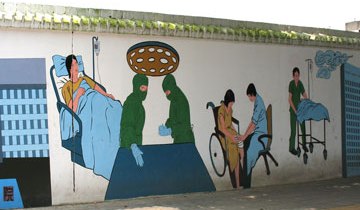
In recent decades, medical system
innovation at Kunming Medical University’s #1 Affiliated Hospital has
greatly increased the cure rate and improved patient satisfaction. First,
the #1 Affiliated Hospital (the biggest hospital in Yunnan Province) was
built in 1941 and currently has 1995 medical staff members (11 doctoral
tutors, 287 master tutors and 86 expatriates). Most of the staff have
earned a Master’s Degree or above. Twenty years ago, most had only a
Bachelor’s Degree or Associate’s Degree. Thus, today’s highly qualified
medical staff can give patients more accurate therapy. Secondly, important
medical equipment has been replaced or improved in recent years. The
introduction of a MRI and a PET machine has played an important role in
diagnosing diseases. Thirdly, more emphasis has not only been put on the
unity and spirit of collaboration among doctors but also on the interests
of the patients. Therefore, better hospital administration has won the
praise of patients. KMU’s #1 Affiliated Hospital’s skilled medical staff,
high-tech medical equipment and satisfying hospital administration have
provided a healthy and harmonious medical environment that meets the
standards of China’s more advanced hospitals.
Group O09:
Li Min, Ray, Kallie, Jerry, Chen Yangping
This part of the mural highlights the importance of sterile conditions in
the practice of modern medicine. An antiseptic mentality is especially
important because it is the key to the success of an operation. The
development of aseptic techniques is considered basic to the development
of surgery. In 1846, Doctor Semmelweis washed his hands with bleaching
powder before surgery, which reduced the death rate (by 1-10%) caused by
infection. Then Doctor Lister made efforts to decrease the rate (by
15-46%) by using carbolic acid to sanitize the operation equipment and
soak the gauze. Since then, aseptic techniques have continued to develop.
Today, the surgeon who holds an antiseptic mentality seriously and
complies with the system strictly will doubtlessly be able to greatly
reduce the infection rate; those who don't, risk the most terrible result:
the patient's death. As shown in the picture, sterilized needles,
germ-free bandages and blankets, and a disinfected operating theater are
all part of the antiseptic mentality necessary for success in surgery and
hospital care.
Team O07: Lucy, Ilana, Allen, Mike |
|
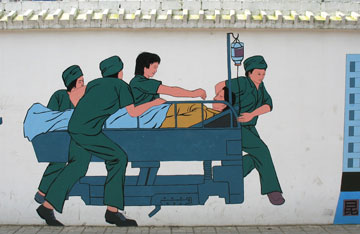
What is the Emergency Room?
The emergency room is a busy place where
medical personnel must quickly intervene to save lives and handle
accidents. Emergency treatment is urgent after accidents, can stabilize a
patient’s condition, and plays a great role in rehabilitation. An
emergency room is an indispensable department for every hospital. Common
cases in emergency rooms include fractures, myocardial infarction, and
shock. These cases often threaten patients’ lives, so doctors need to
handle them quickly to keep the condition from deteriorating. Some key
points should be emphasized when conducting emergency treatment, such as
keeping the airway unobstructed, carrying out effective artificial
respiration, and establishing active artificial circulation, and priority
should be given to time. Doctors must inquire into the cause of disease or
injury, grasp the patient’s condition, and swiftly take measures to save
lives. In conclusion, emergency treatment keeps people alive in urgent
situations, helps restore health after accidents, and calls for
comprehensive skill and a quick mind.
Group P09:
Susan, Xu Shihong, Marsha, Sophie, Chen Fangjin, Tian Ziyang
Emergency medical treatment (EMT) is a
critical link between the public and the health care system. When people
suffer from an accident, the emergency personnel immediately and
skillfully treat the patient, using practical resources on the scene. The
purpose is to save life, to stabilize patients and to help physicians to
make a diagnosis and start treatment. When the patient is sent to the
hospital, EMT personnel give doctors information about the patient’s
initial complaint, vital signs, age, medical history, and resources used.
This helps doctors make decisions about whether the patient should have
other tests before they make a diagnosis and give treatments. In a large
sense, on-the-scene life-saving Emergency Medical Treatment is the front
door to the hospital's emergency department. Team P07: Li Chun, Zhang Jingqiu, Dong Xiaohua, Duan Hongdan |
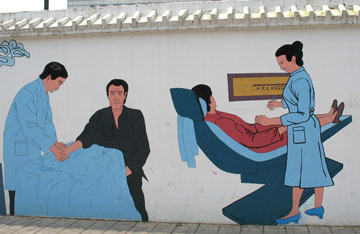
Sphygmopalpation and Acupuncture
Sphygmopalpation and Acupuncture Therapy,
two classical forms of Traditional Chinese Medicine (TCM), continue to be
used successfully for diagnosis and treatment both in China and abroad.
Sphygmopalpation is also known as “feeling the pulse”. Its history can be
traced back to 1,500 years ago when the systematic theory appeared in
《濒湖脉学》
(Bin Hu Mai Xue), written by Li
Shizhen in the Ming dynasty. It is a vital TCM method of diagnosis that
helps doctors understand the patients’ internal disease development by
touching their pulse, for the pulse’s location, rhythm and effect can
reflect the fundamental condition of the heart and arteries. Acupuncture
Therapy, another classic TCM treatment therapy, includes acupuncture (针术)
and moxibustion (灸术),
dating back to《黄帝内经》
(Huang Di Nei Jin) 2,000 years ago. As methods of treatment, acupuncture
and moxibustion act on nerve regulation by pricking and fumigating
(respectively) certain acupoints on the body’s surface. According to a
report from the Fifteen-year Anniversary of the International Acupuncture
Association, these excellent TCM methods were being used in 142 countries
by 2005. Sphygmopalpation (diagnosis by feeling the pulse) and Acupuncture
Therapy (treatment by pricking and fumigation) not only continually
contribute to Chinese people’s health, but these time-honored forms of TCM
are becoming increasingly helpful in foreign countries as well.
Group Q:
Ann, He Liang, Sunny, Sophia, Liu Lian, Chen Ying
When doctors need to make a diagnosis they may utilize high tech
instruments or may simply touch your pulse; modern techniques and ancient
methods may be used side by side. In the old times, medicine was based on
religious ideas and people's life experiences. Doctors used the
medications passed from generation to generation to treat their patients.
By contrast, modern medicine is based on a growing scientific
understanding of how the body works and how microscopic things (e.g.,
viruses and bacteria) affect health. Modern diagnostic methods include
biopsy, autopsy and experimentation. High-tech instruments are important
because the doctor can't make an accurate diagnosis without reliable
information. But the practice of modern medicine has absorbed some ways
from traditional medicine. For instance, acupuncture still plays an
important role in alleviating pain, and message (touch therapy) can help
release the patient's anxiety. Thanks to the trend of combining modern
medicine and traditional medicine, doctors are making steady progress in
conquering disease.
Team Q07: Allen, Andrew, Luyi, Michael, Zhaopeng |
|
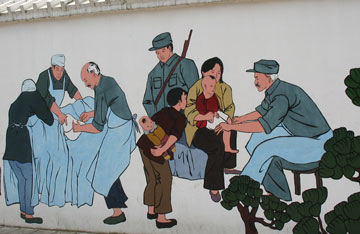
During China’s war of resistance against
Japan, Dr. Henry Norman Bethune, a Canadian communist, made a great
contribution to China’s liberation by treating casualties and civilians,
and enhancing China’s medical level. In 1938 and 1939, this surgeon led
his medical specialists to help Chinese people struggle against Japan by
supplying numerous drugs and medical instruments. Without regard for his
safety, he set up a mobile army surgical hospital near the front lines to
provide timely emergency care and save casualties’ lives. Behind the front
lines, Bethune lived harmoniously with local people and he supplied free
treatment for the elderly, children, and the sick. To reduce mortality
rates, Bethune worked to enhance China’s medical level. He organized local
people to make various medical instruments, gave classes to medical
staffs, and compiled medical materials, cultivating capable medical
workers. Dr. Bethune’s enormous contribution during China’s war of
resistance against Japan, saving soldiers’ lives, caring for common people
and improving the state of the medical care in China, has left a lasting
legacy that is dear to the people of China.
Group S09:
Yu Danping, Li Fang, Lu Chenghua, Shi Cong, Dong Xigang, Zhao Jing
This part of the mural reminds us of the uncountable number of operations
Dr. Bethune and other army medical personnel did to save Chinese soldiers
and villagers' lives during the War of Resistance against Japan. Military
doctors performed many miracles when helping Chinese people, including
some operational records that can't even be broken now. Most primary
school children are deeply moved when reading "In Memory of Norman
Bethune," which is an introduction to this great man who was a member of
the Communist Party of Canada. In this article, Chairman Mao writes: "What
kind of spirit is this that makes a foreigner selflessly adopt the cause
of the Chinese people's liberation as his own? It is the spirit of
internationalism, the spirit of communism, from which every Chinese
Communist must learn." Even today, medical students can learn from Dr.
Bethune's medical ethics. Medical ethics can not only affect a doctor's
attitude to his patients, but also his medical skills. Modern China is not
isolated from the rest of the world or from its own history; the spirit of
internationalism and the medical ethics of historical figures like Dr.
Bethune are still important to the practice of medicine in China.
Team R07: David, Kitty, Jane, Lucy, Trudy |
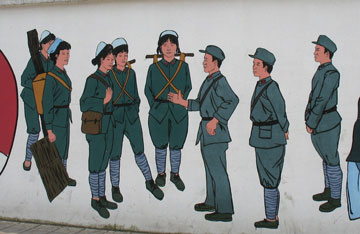
During the Anti-Japanese War (1937 to
1945), the Chinese army’s medical and health services team played an
important role in healing the wounded and rescuing the dying. After the
outbreak of the war, Chinese people had to fight against Japanese
Imperialism for eight years, and the medical workers actively took part in
the battles. The team members rushed to the battlefield to do first-aid,
such as stopping bleeding, binding up wounds, fixing broken bones and
transporting the injured to a base hospital in order to receive better
treatment. At the same time, they taught soldiers how to administer
life-saving emergency care to each other when they faced critical
situations. Thanks to the contribution of this special medical community,
the sick and wounded’s suffering was alleviated and their lives were saved
so as to assure the army’s combat effectiveness. In an extremely difficult
environment, military medics combined their knowledge and zeal to render
and teach emergency care, which contributed to military readiness and
helped China win the final victory in the Anti-Japanese War.
Group T09:
Meredith, Loller, Tony, Mandy, Jessica, Luan Yumin
War
is one of the world's most serious threats to health, and health care has
always played a very important role in war, especially China's eight-year
War of Resistance Against Japan (1937-1945). There were many great heroes
in the ruthless battles, and countless people had to pay with their lives.
Since wartime injuries were common, the doctors' main task became treating
the injured soldiers and minimizing the damage. Many doctors were not
afraid of sacrifice. They wore white coats in the field hospitals near the
front lines. Hospitals and aid stations were frequently understaffed.
Shabby houses became the operating rooms. In spite of medicine shortages
and the lack of facilities, doctors saved many soldiers' lives under harsh
conditions. Killing and healing are strange companions, but the Chinese
people will always cherish the contributions made by heroic soldiers in
the operating rooms—China's brave military medical personnel.
Group S07: William, Panjing, Lemon, Jackson |
|
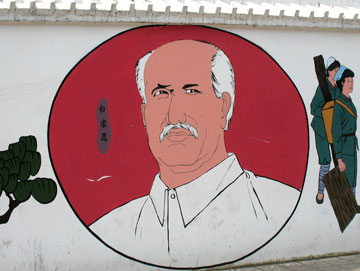
Dr.
Henry Norman Bethune
Dr. Henry Norman Bethune, a Canadian thoracic surgeon and an international
Communist medical officer, is highly honored by the Chinese people for his
selfless work during China's Anti-Japanese War. Bethune was born in Graven
Hurst, Ontario, Canada in 1890. He graduated from the medical school of
Toronto University in 1913 and became a thoracic surgeon. After joining
the Communist Party, he organized Canadian medical aid and set up the
world's first mobile blood transfusion unit during Spain's Civil War
(1936-1931). Then in 1938, Bethune came to China, leading a medical team
composed of Canadian and American medical personnel, to serve during the
Chinese Anti-Japanese War. He successfully conducted as many as 300
operations in front-line hospitals. In order to improve the state of
medical care in China, he also trained Chinese medics in many areas, such
as blood transfusion. In 1939, Bethune died from a finger infection
sustained in an operation. Since then, China has named many hospitals and
schools in memory of Bethune, as well as making several movies about him.
Selfless medical work in Canada, Spain and China, including his work as a
military surgeon and medical trainer, has made Dr. Henry Norman Bethune an
international Communist hero who is especially dear to the Chinese people.
(208 words)
Group U09: Vivian, Jim, Liu Rui, Evelyn, Wang Dong, Echo
Henry Norman Bethune (1890-1939) was a great doctor dedicated to serving
humanity. In 1938, as a thoracic surgeon and member of the Canadian
Communist Party, he came to China for humanitarian reasons to perform
operations to Chinese soldiers. The Encyclopedia of World Biography (EWB)
says: "In the rugged mountainous area west of Beijing,… [Bethune]
constructed makeshift hospitals throughout the region, wrote textbooks on
elementary medicine and surgery, and began training young Chinese in
rudimentary medical techniques." Bethune's medical team was normally only
a few kilometers from the front lines; indeed they were even behind
Japanese lines much of the time. They set up their mobile operating
theater wherever it was needed most, responding quickly to the call of
army commanders. Unfortunately, in 1939, he died of blood poisoning from a
cut he received while performing surgery. In the 1960s, in order to
memorialize Dr. Bethune's sacrifice, Chairman Mao published his essay
entitled “In Memory of Norman Bethune,” which documented the final months
of the doctor's life in China. Since then, many Chinese people have
learned about the spirit of absolute selflessness by reading about Dr.
Bethune, who showed that everyone can be very useful to society.
(parts of this were essay were adapted from the EWB as cited at
http://www.pbs.org/wnet/redgold/innovators/bio_bethune.html)
Team T07: Sharron, Mason, Emma, Iris, Winson |

How
Group Presentations Help the Students
Doing group presentations this semester brought many benefits to the
students, including cultivating collaboration abilities and greater
proficiency in using computers, inspiring a greater interest to learn
English. Firstly, the semester’s presentations could not be done alone,
but required students to work together. In order to successfully finish
the work, group members had to communicate and collaborate with each
other. Secondly, in skits and role plays, students performed in front of
others and acted like real actors, and this positive experience promoted
English development. Acting really increases one’s confidence in speaking
English. In addition to cultivating collaboration abilities, students
became more proficient in using computers while doing the work. In fact,
since all of the contents stemmed from only a photo, participants had to
both exercise imagination and conduct research on the Internet. The
project helped students become more proficient in using MS Word and
PowerPoint software in English. Many students enjoyed the project and its
positive benefits—collaboration, communication, acting, researching,
developing computer skills, and the chance to express creative ideas—which
have helped rekindle motivation to learn English. (180 words)
Group V09: Yi Juan, Duan Xiaofei, Zhou Ji, Jiang Jie, Yang Mei, Chen Hao
The
final section of this mural shows Dr. Bethune working in the shadow of the
First Affiliated Hospital of Kunming Medical University. Kunming Medical
University (KMU) has a deep affinity with Doctor Bethune because the
university's first Assistant Dean, Yan Yi-quan, was Dr. Bethune's medical
assistant during a battle in China's fight against Japanese aggression. In
1938, working as a military doctor, Yan Yi-quan met and had a chance to
work with this outstanding Canadian doctor. Unfortunately, in 1939, Dr.
Bethune sacrificed his life to save a wounded soldier. Although Dr.
Bethune passed away, his spirit about caring for patients with all his
heart and soul had been deeply planted in Dr. Yan's heart. After the
victory in that war, Dr. Yan spared no effort in his practice of medicine
to improve the whole nation's lifestyle. Later when Dr. Yan worked at KMU,
he took the spirit of Dr. Bethune seriously when instructing and managing
the students. Many of the interns who have served in KMU's #1 Affiliated
Hospital heard Dr. Yan say that just as Dr. Bethune was a man who had a
magnificent character and selfless dedication, medical students should try
to be perfect doctors for the remainder of their lives.
Team U07: Terry, Ding Lin-fen, Gao Ying-ying, Wu Lin-xiong, Xiao Yu-liang
Click here for page one |
|
This resource was created for and by our students under my
understanding of "fair use" for educational resources.
I apologize if the students plagiarized from other
sources without telling me!
As far as I am concerned, people are allowed to
print/copy it for personal or classroom use.
If you print/use this, please see Website
Standards and Use Policy for things posted at www.krigline.com and
www.krigline.com.cn.
|

Click in the boxes below to go to some of our most popular pages. If
you get lost, just click "Home."
See our
Policy
regarding the use of materials available at Krigline.com or
Krigline.com.cn |









